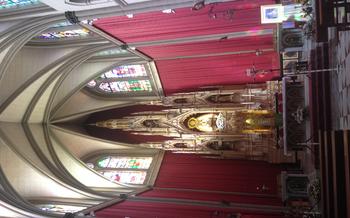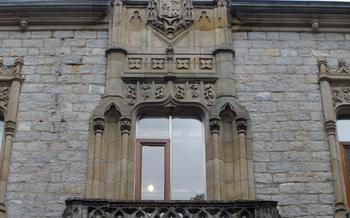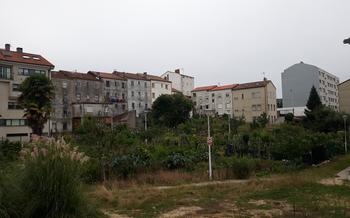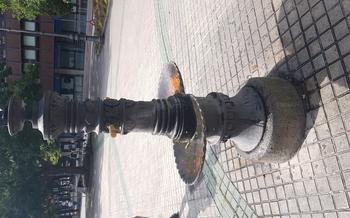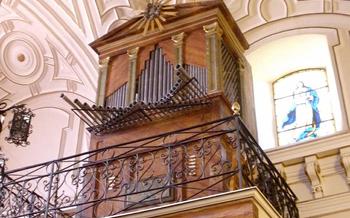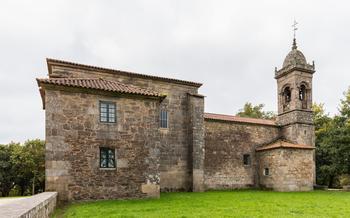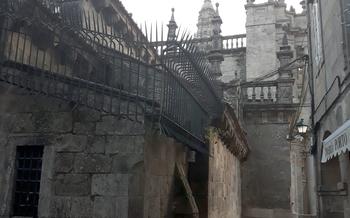
Estíbaliz (Sanctuary of Our Lady of Estíbaliz)
- Visit the Sanctuary of Our Lady of Estíbaliz
- Admire the Sanctuary's Gothic Architecture:
- Explore the Sanctuary's Interior
- Attend a Religious Service or Mass
- Take a Guided Tour:
- Enjoy the Scenic Views from the Sanctuary
- Visit the Sanctuary's Museum
- Attend the Sanctuary's Annual Festival
- Hike or Bike in the Surrounding Area:
- Explore the Nearby Towns and Villages
- Take a Pilgrimage to the Sanctuary
- Learn about the Sanctuary's Patron Saint
- Experience the Sanctuary's Accommodation and Hospitality
- Support Local Crafts and Products
- Insider Tip: Discover the Sanctuary's Secrets
Visit the Sanctuary of Our Lady of Estíbaliz
Nestled amidst the rolling hills of the Basque Country, the Sanctuary of Our Lady of Estíbaliz stands as a testament to centuries of faith and devotion. Its history is deeply intertwined with the region's cultural and religious heritage, dating back to the 9th century when a humble chapel was first erected on this site. Over time, the sanctuary grew in prominence, attracting pilgrims and worshippers from far and wide. In the 12th century, it was rebuilt in the Gothic style, reflecting the architectural trends of the time.
The sanctuary's architectural features are a testament to the skill and artistry of medieval builders. Its Gothic design is characterized by pointed arches, ribbed vaults, and intricate stone carvings that adorn the façade and interior. The sanctuary's religious significance is profound, as it is dedicated to the Virgin Mary, who is revered as the patron saint of the Basque Country. Local legends and traditions are closely associated with the sanctuary, adding to its mystical aura and making it a beloved destination for both religious and cultural pilgrims.
Admire the Sanctuary's Gothic Architecture:
The Sanctuary of Our Lady of Estíbaliz showcases stunning Gothic architecture, a style that emerged in the Middle Ages and left an enduring mark on religious and secular buildings across Europe. Its unique features include the pointed arches that soar towards the sky, creating a sense of height and grandeur. The intricate ribbed vaults, supported by slender columns, lend a sense of lightness and elegance to the interior.
The construction of the sanctuary began in the 13th century, reflecting the increasing popularity of the Gothic style in Spain. The design of the sanctuary incorporates Gothic elements such as the rose window, which allows colorful light to filter into the interior, and the flying buttresses, which provide structural support to the walls while creating a dynamic visual effect.
The influence of Gothic architecture in Spain can be seen in many other iconic structures, such as the cathedrals of Burgos, León, and Seville. The Gothic style represented a departure from the Romanesque style that had dominated religious architecture in the Iberian Peninsula until then. It embraced a new aesthetic that emphasized verticality, light, and the representation of Biblical narratives through intricate carvings and sculptures.
The historical context of Gothic architecture is closely linked to the rise of urban centers and the increasing power of the Catholic Church during the Middle Ages. Gothic cathedrals and churches served as symbols of both religious devotion and civic pride. They were often built to accommodate growing congregations, becoming focal points of community life and showcasing the wealth and prestige of the cities that commissioned them.
Explore the Sanctuary's Interior
The interior of the Sanctuary of Our Lady of Estíbaliz is a treasure trove of religious art and symbolism. Its layout is typical of Gothic churches, with a central nave flanked by two aisles and a series of chapels. The most notable feature is the magnificent altarpiece, which is considered one of the finest examples of Gothic sculpture in Spain. The altarpiece depicts scenes from the life of Christ and the Virgin Mary, and is adorned with intricate carvings and polychrome details.
Other notable artworks in the sanctuary include a 13th-century statue of Our Lady of Estíbaliz, a series of Renaissance paintings depicting the life of St. Francis, and a collection of medieval stained-glass windows. The sanctuary also houses a number of relics, including a fragment of the True Cross and a thorn from the Crown of Thorns.
The interior of the sanctuary is a place of great spiritual significance. It is a place where pilgrims have come for centuries to pray and seek solace. The atmosphere is one of peace and tranquility, and the beauty of the artwork and architecture inspires a sense of awe and wonder.
Restoration and conservation efforts
The Sanctuary of Our Lady of Estíbaliz has undergone a number of restoration and conservation projects over the years. The most recent project, which was completed in 2021, involved the restoration of the altarpiece, the stained-glass windows, and the roof. The project was carried out by a team of experts who used traditional techniques to ensure that the sanctuary's original beauty and integrity were preserved.
Attend a Religious Service or Mass
The Sanctuary of Our Lady of Estíbaliz is an active place of worship, and visitors are welcome to attend religious services or mass. The sanctuary's schedule varies throughout the year, but there are typically several services held each day. Visitors can check the official website or inquire at the sanctuary's reception for specific times and details.
Attending a religious service or mass at the sanctuary is a unique and immersive experience that allows visitors to witness the local religious traditions firsthand. The services are conducted in Spanish and Basque, and visitors can observe the rituals and customs of the local Catholic community. The sanctuary's acoustics are excellent, and the music and singing during the services are particularly moving.
The sanctuary is a significant place of pilgrimage, and many pilgrims visit the sanctuary to pray, seek blessings, and offer thanks to Our Lady of Estíbaliz. Visitors can join the pilgrims in prayer or simply observe the spiritual atmosphere of the sanctuary.
During religious services, it is important to be respectful and mindful of the sacred nature of the occasion. Visitors should dress appropriately, refrain from talking or using electronic devices, and follow the lead of the local worshippers. This will ensure a peaceful and meaningful experience for all.
Take a Guided Tour:
Guided tours of the Sanctuary of Our Lady of Estíbaliz offer an enriching and comprehensive experience for visitors. Led by knowledgeable guides, these tours delve into the history, significance, and hidden details of the sanctuary. Advance booking is recommended to secure a spot and avoid disappointment.
The tours provide insights into the sanctuary's construction, architectural features, and religious importance. Guides share fascinating stories and anecdotes related to the sanctuary's past, bringing its history to life. They also point out notable artworks, symbolism, and iconography, enhancing visitors' understanding and appreciation of the sanctuary's artistic and spiritual significance.
Beyond the sanctuary itself, guided tours often include a visit to the museum, where visitors can explore exhibits and artifacts related to the sanctuary's history and heritage. Guides provide context and explanations, helping visitors connect the dots and gain a deeper understanding of the sanctuary's evolution over time.
For those seeking a more immersive and personalized experience, private guided tours can be arranged, allowing visitors to customize their itinerary based on their interests and preferences. Whether you're a history buff, an architecture enthusiast, or simply someone seeking a deeper connection with the sanctuary, a guided tour is an excellent way to unlock the secrets and treasures of this sacred place.
Enjoy the Scenic Views from the Sanctuary
The Sanctuary of Our Lady of Estíbaliz offers breathtaking panoramic vistas of the surrounding countryside, making it a perfect spot to soak in the natural beauty of the Basque Country. From the sanctuary's elevated position, visitors can gaze upon rolling green hills, lush forests, and distant mountain peaks, all framed by the ever-changing Basque sky.
One of the most popular vantage points is the sanctuary's terrace, which offers unobstructed views of the landscape. Here, visitors can relax on benches or lean against the stone balustrades, taking in the tranquil scenery and enjoying the fresh air. The terrace is also an ideal spot for photography enthusiasts, who can capture stunning images of the sanctuary set against the backdrop of the Basque countryside.
Another must-visit spot for panoramic views is the sanctuary's bell tower. Although it requires a bit of a climb, the effort is well worth it. From the top of the tower, visitors are rewarded with breathtaking 360-degree views that stretch for miles in every direction. The bell tower is particularly popular during sunset, when the sky transforms into a canvas of vibrant colors, casting a warm glow over the surrounding landscape.
Visit the Sanctuary's Museum
The Sanctuary of Our Lady of Estíbaliz houses a captivating museum that delves into the rich history and cultural significance of this sacred site. Within its walls, visitors can embark on a journey through time, exploring exhibits and collections that showcase artefacts, documents, and relics that narrate the sanctuary's captivating story.
Interactive displays and educational resources bring the sanctuary's heritage to life, providing visitors with a deeper understanding of its role in the religious and cultural tapestry of the Basque Country. Through these exhibits, visitors can gain insights into the sanctuary's architectural evolution, its religious significance, and the lives of those who have dedicated themselves to its care and preservation.
The museum serves as a treasure trove for history buffs, art enthusiasts, and pilgrims seeking a deeper connection to the sanctuary's spiritual essence. It is a place where the past and present converge, offering visitors a unique opportunity to immerse themselves in the sanctuary's enduring legacy.
Attend the Sanctuary's Annual Festival
One of the best ways to experience the vibrant spirit of the Sanctuary of Our Lady of Estíbaliz is to attend its annual festival. This grand celebration, held on September 8th, draws thousands of pilgrims and visitors from across the region to honor the sanctuary's patron saint, Our Lady of Estíbaliz.
The festival is a fusion of religious devotion, cultural traditions, and joyous festivities. It kicks off with a solemn mass followed by a colorful procession, where the statue of Our Lady of Estíbaliz is carried through the streets accompanied by music, dancing, and traditional costumes.
Throughout the day, the sanctuary grounds come alive with a vibrant fair, featuring local artisans showcasing their crafts, food stalls offering traditional Basque delicacies, and lively performances showcasing the region's rich folklore. Visitors can immerse themselves in the local culture, enjoy traditional music and dance, and savor the festive atmosphere.
The festival culminates in a spectacular fireworks display, illuminating the night sky above the sanctuary, creating a magical and unforgettable experience. It is a moment of awe and wonder, leaving visitors with a lasting memory of the Sanctuary of Our Lady of Estíbaliz and its annual celebration.
Hike or Bike in the Surrounding Area:
The Sanctuary of Our Lady of Estíbaliz is nestled amidst the breathtaking natural beauty of the Basque Country. The surrounding area offers a myriad of opportunities for outdoor enthusiasts and nature lovers. Explore the picturesque landscapes by embarking on a hike or bike ride along well-maintained trails that wind through forests, meadows, and hills. Marvel at the stunning vistas of rolling green hills, lush valleys, and distant mountain ranges. Embrace the tranquility and serenity of the natural environment as you immerse yourself in the beauty of the Basque countryside.
Whether you prefer a leisurely stroll or a challenging mountain bike adventure, there are trails suitable for all fitness levels. Discover hidden waterfalls, ancient ruins, and charming villages along the way. Take a break to enjoy a picnic lunch amidst the natural splendor, surrounded by the sounds of birdsong and the rustling leaves. The integration of the sanctuary with the natural environment creates a harmonious blend of spirituality and outdoor adventure, making it an ideal destination for those seeking a holistic and rejuvenating experience.
Explore the Nearby Towns and Villages
Vitoria-Gasteiz is a charming city, but there are many other hidden gems to discover in the surrounding area. Laguardia is a medieval walled town with picturesque streets and wineries. Elciego boasts the Frank Gehry-designed winery, Marques de Riscal. Labastida is a beautiful town with a rich history and stunning views of the surrounding countryside.
For a taste of Basque culture, head to Oñati to visit the University of Oñati, founded in 1540, and the Sanctuary of Arantzazu, a modern masterpiece of Basque architecture. Durango is a lively town with a vibrant arts scene, while Gernika is home to the Basque Peace Museum, which tells the story of the Basque people's struggle for peace and independence.
If you're looking for a beach getaway, head to the coastal town of Zarautz, known for its beautiful beach and surf culture. Getaria is another popular beach town with a charming old town and the birthplace of the famous fashion designer, Cristóbal Balenciaga.
No matter where you choose to explore, you're sure to find something to love in the towns and villages surrounding Vitoria-Gasteiz. So rent a car or hop on a bus and discover the hidden treasures of the Basque Country.
Take a Pilgrimage to the Sanctuary
The Sanctuary of Our Lady of Estíbaliz holds a special place in the hearts of pilgrims, who have been drawn to this sacred site for centuries. The sanctuary's history as a pilgrimage destination can be traced back to the Middle Ages, when it was believed that the Virgin Mary appeared to a shepherd on the site. This event sparked a wave of devotion to Our Lady of Estíbaliz, and pilgrims began to flock to the sanctuary in search of spiritual guidance and healing.
In the modern era, the tradition of pilgrimage to the Sanctuary of Our Lady of Estíbaliz continues, with pilgrims from all over the world making the journey to this holy place. The sanctuary offers a variety of pilgrimage routes, each with its own unique challenges and rewards. Some pilgrims choose to walk the entire distance, while others opt for shorter routes that can be completed in a single day.
No matter which route you choose, the experience of pilgrimage to the Sanctuary of Our Lady of Estíbaliz is sure to be a transformative one. The journey provides an opportunity for reflection, prayer, and spiritual growth, as pilgrims connect with their inner selves and with the divine. Along the way, pilgrims can marvel at the stunning scenery of the Basque Country, and experience the warm hospitality of the local people.
Whether you are a seasoned pilgrim or a first-timer, the Sanctuary of Our Lady of Estíbaliz is a must-visit destination. The sanctuary's rich history, stunning architecture, and powerful spiritual energy make it a place of pilgrimage that is both inspiring and unforgettable.
Learn about the Sanctuary's Patron Saint
At the heart of the Sanctuary of Our Lady of Estíbaliz lies a figure of great reverence and devotion: Our Lady of Estíbaliz, the patron saint of the sanctuary and a symbol of faith for the Basque people. Her story is interwoven with local traditions, miracles, and legends, adding a layer of spiritual and cultural significance to the sanctuary.
According to local lore, the Virgin Mary appeared to a shepherdess named Isabel in the 11th century, instructing her to build a chapel in her honor. The shepherdess, known as "Isabel of Estíbaliz," faithfully carried out the Virgin's request, and the chapel eventually grew into the magnificent sanctuary that stands today.
Over the centuries, Our Lady of Estíbaliz became a revered figure, attracting pilgrims from far and wide. Devotees sought her intercession for healing, protection, and guidance. Numerous miracles and legends are attributed to her, further solidifying her status as a beloved saint in the Basque Country.
One of the most famous legends tells of a battle in the 13th century, when the Virgin Mary appeared to the Basque warriors, leading them to victory against their enemies. This miraculous intervention earned her the title of "General of the Basque Army," and her image is often depicted in armor, symbolizing her role as a protector and guardian of the Basque people.
Exploring the Sanctuary of Our Lady of Estíbaliz is not just a journey through architectural marvels and religious history; it is also an opportunity to delve into the rich tapestry of Basque culture and traditions. Through the stories and legends surrounding Our Lady of Estíbaliz, visitors can gain a deeper understanding of the profound faith and devotion that permeate this sacred place.
Experience the Sanctuary's Accommodation and Hospitality
For those seeking a truly immersive experience, the Sanctuary of Our Lady of Estíbaliz offers a range of accommodation options that cater to pilgrims, travelers, and those seeking spiritual retreats. The sanctuary's pilgrim hostel provides basic yet comfortable lodgings for those undertaking the Camino de Santiago or simply seeking a simple and affordable place to stay. Guests can choose from shared dormitories or private rooms, all equipped with essential amenities.
For those seeking a more tranquil and private experience, the sanctuary also offers guesthouses with en-suite bathrooms and stunning views of the surrounding countryside. These guesthouses are ideal for couples, families, or individuals seeking a peaceful retreat. The sanctuary also hosts spiritual programs and retreats throughout the year, providing an opportunity for visitors to deepen their connection with their faith and explore their spirituality in a supportive and nurturing environment.
The sanctuary's commitment to hospitality extends beyond its accommodation offerings. Visitors can enjoy delicious and wholesome meals prepared with local ingredients at the sanctuary's restaurant. The restaurant offers a range of traditional Basque dishes, as well as lighter options and vegetarian choices. Whether you're a pilgrim seeking sustenance or a traveler looking to sample the local cuisine, the sanctuary's restaurant is sure to delight your palate.
Support Local Crafts and Products
The Sanctuary of Our Lady of Estíbaliz is nestled in a region renowned for its rich craftsmanship and local products. Take the opportunity to support the local economy and bring home a piece of Basque culture. Visit the artisan workshops and markets to discover handmade ceramics, leather goods, jewelry, and textiles created by skilled local artisans. Taste and purchase the region's culinary delights, such as locally produced cheeses, wines, and traditional sweets. By supporting local businesses and craftspeople, you contribute to preserving the region's cultural heritage and traditions while taking home unique souvenirs to cherish.
Insider Tip: Discover the Sanctuary's Secrets
-
Venture beyond the main sanctuary building to explore the picturesque cloister, a tranquil oasis adorned with Gothic arches and intricate carvings.
-
For a unique perspective, climb to the sanctuary's bell tower (Torre de Campanas) and enjoy breathtaking panoramic views of the surrounding countryside.
-
Capture the sanctuary's ethereal beauty during the golden hours of sunrise and sunset, when the warm hues illuminate the stone facade and create a magical atmosphere.
-
Immerse yourself in the local culinary scene by savoring traditional Basque dishes at nearby restaurants. Don't miss the opportunity to try "pintxos," bite-sized Basque tapas, which offer a delectable variety of flavors.
